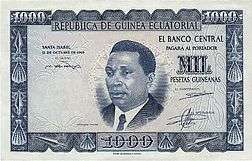Equatorial Guinean peseta
| Equatorial Guinean peseta | |
|---|---|
| peseta guineana (Spanish) | |
|
Old Equatorial Guinean 1000 pesetas banknote, 1969 | |
| Denominations | |
| Plural | pesetas |
| Banknotes | 100, 500, 1000 ₧ |
| Coins | 1, 5, 25, 50 ₧ |
| Demographics | |
| User(s) | Equatorial Guinea |
| Issuance | |
| Central bank | Banco de Guinea Ecuatorial |
|
This infobox shows the latest status before this currency was rendered obsolete. | |
The peseta (peseta guineana) was the currency of Equatorial Guinea from 1969 to 1975. It replaced the Spanish peseta at par and was replaced, at par, by the ekwele.
Coins
Four denominations of coins were issued, all dated 1969. These were 1, 5, 25 and 50 pesetas. The coins were the same size as the corresponding Spanish peseta coins.
Banknotes
Three denominations of banknotes were issued dated 12 DE OCTUBRE DE 1969. These were 100, 500 and 1000 pesetas. In 1975, notes denominated in ekuele replaced the peseta guineana at par. In 1979, the portrait of Francisco Macías Nguema was removed from the currency of Equatorial Guinea after his overthrow on 3 August 1979, and subsequent execution on 29 September following a guilty verdict for crimes including genocide, mass murder, embezzlement of public funds, violations of human rights, and treason. The traditional coat of arms was also restored. Concurrent with the release of these new notes, the name of the currency was also changed from ekuele (plural ekuele) to ekwele (plural bipkwele). Equatorial Guinea entered the Franc Zone on 2 January 1985. The ekwele was replaced by the Central African franc (written Franco on these notes) at a rate of 1 franc = 4 bipkwele. In the late 1980s, Equatorial Guinea joined the Central African States, which issued its notes thereafter.[1]
References
- ↑ Linzmayer, Owen (2012). "Equatorial Guinea". The Banknote Book. San Francisco, CA: www.BanknoteNews.com.
